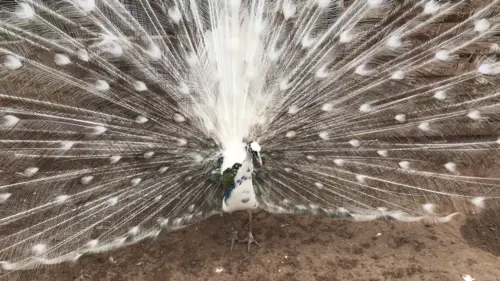Silver Pied Peacocks
The silver pied peacock is a white bird with some color on it. They have 80 to 90% white and 10 to 20% colored bodies. Peacocks with this pattern also have green or blue on their neck. The distinctive silver-white feathers are the most striking features of these birds.
In 1992, the silver pied bird originated in the USA. Three breeders discovered this peafowl mutation at about the same time. It is the newer variety and become famous in the recent few years. Additionally, after extensive work by breeders, they can be found in many variations.

Development of Silver Pied Peacock:
The pied and white-eyed genes collaborate with the white gene, resulting in the silver-pied peafowl. The silver pied pattern can be produced in any peacock color, like a pied pattern. These silver-pied birds developed through Indian blue-white eyes but can also be found in other colors, including Spalding, cameo, purple, etc.
Is Silver Pied a color mutation of Indian Blue
Silver pied is a result of pattern mutation, however, the color of the silver pied peacock is similar to Indian blue. In the silver pied pattern, The colored body of the silver pied peacock is just 20% while 80% of the body is white.
Appearance:
The silver pied peafowl has a 20% white and 80% color appearance. This male bird can be dark silver pied or light silver pied. When silver pied peacocks grow fully, they have white-eyed feathers on their train. They also have white and blue chests, necks, and heads. Additionally, these male birds have long tails like other peafowls.
The silver pied peahens are pretty to look at. The female birds have the same pattern as male birds but they have silver and white on their body. They have grey necks, and you may also see some green feathers on their neck.
Variations of Silver Pied Peacocks
The varieties of silver pied peafowls are available in all the major color types due to the extensive work of breeders during the last 20 to 25 years. These silver pied birds come in unique coloration, so you will not find two similar birds. Following are the variations of silver pied peacocks.
- Cameo Silver Pied
- Purple Silver Pied
- India Blue Silver Pied
- Purple Black Shoulder Silver Pied
- Taupe Silver Pied
- Black Shoulder Silver Pied
- Bronze Black Shoulder Silver Pied
- Cameo Black Shoulder Silver Pied
- Bronze Silver Pied
- Spalding Silver Pied
- Violet Silver Pied
- Midnight Silver Pied
- Opal Silver Pied
- Peach Silver Pied
- Spalding Jade Silver Pied
- Taupe Black Shoulder Silver Pied
- Midnight Black Shoulder Silver Pied
- Charcoal Silver Pied
- Opal Black Shoulder Silver Pied
- Spalding Black Shoulder Silver Pied
- Spalding Purple Silver Pied
Male and Female Difference
Both silver pied peacock and peahen have stunning and eye-catching appearances. The difference between male and female silver pied is their neck color. The silver pied peacock has a blue or green neck while the silver pied peahen comes with a grey neck.
FAQs:
How to recognize a silver pied peachick?
It’s often easy to identify a silver-pied peachick as they have a small streak of grey on their wings.
When did Peacocks UK introduce the silver pied peafowls?
The first silver pied peacock was introduced in the UK in 2011.
How many varieties of silver pied peacocks are there?
There are around 21 varieties of silver pied peacocks such as opal silver pied, peach silver pied, spalding jade silver pied, etc.
What is the difference between silver pied and dark pied?
Both silver pied and dark silver pied are patterns of peafowl birds. They can be found in 19 different colors.
When breeding two silver-pied birds, what will the chicks be?
After breeding two silver pied birds, the chicks will be 50% silver pied, 25% white, and 25% dark silver pied white-eyed.
Conclusion:
Silver pied peacocks are a unique and majestic variety of peafowl birds. They can be great additions to your backyard along with other birds. If you are interested in these silver-pied peacocks and want to keep them as pets, providing them with a safe and warm environment is important as they are sensitive to cold weather. Additionally, you need to prioritize their health care, dietary care, and veterinary check-ups to ensure they live a healthy life.







